Secure Automatic Identification System (SecAIS): Proof-of-Concept Implementation
Abstract
:1. Introduction
2. Related Work
3. Maritime Identity-Based Cryptographic Infrastructure (mIBC)
- The Typical-SecAIS (mode 1) is the conventional AIS, for routine use;
- The Authenticated-SecAIS (mode 2) offers source authentication via cryptographically signed AIS messages. An AIS device signs the transmitted AIS data with its mIBC private (secret) key, and the receivers authenticate the signed AIS messages by using only the MMSI of the transmitter vessel;
- The Anonymous-SecAIS (mode 3) offers legitimate anonymous AIS-transmitted messages via “pseudo-MMSIs” that are cryptographically signed by an official mIBC agency. From a cryptographic point of view, the Anonymous-SecAIS (mode 3) is identical to the Authenticated-SecAIS (mode 2), although it uses a pseudo-MMSI instead of the real MMSI of the vessel;
- The SK-IBE-SecAIS (mode 4) allows for the secure transmission of small encrypted AIS messages to a specific entity via an appropriate encryption scheme, such as the Sakai–Kasahara identity-based encryption scheme. It is proposed to be used, mainly, for the secure sharing (or distribution, if there is more than one recipient) of the symmetric keys in the AES-SecAIS (mode 5);
- The AES-SecAIS (mode 5) allows for the transmission of encrypted AIS messages to a group of participants (e.g., trustworthy vessels in an insecure area) via symmetric cryptography (e.g., by means of the advanced encryption standard (AES) [41]). The advantage of our solution is that the keys for the encryption can be generated and disseminated ad hoc, upon request, unlike the current commercially available solutions, e.g., [42,43], where the keys are pre-configured in predetermined users. This approach allows for the ad hoc creation of encrypted AISANETs, described in Section 5.
- The SecAIS-App intercepts the original generated AIS message (e.g., an AIS class A ship static and voyage-related data ID5 [5]);
- The SecAIS-App performs the appropriate cryptographic actions (e.g., signing, encrypting, etc.);
- The SecAIS-App creates conventional AIS binary broadcast messages of types ID8 or ID 6 [5], and it encapsulates the SecAIS data into their “application data payload” section. The SecAIS-App forwards the newly created, conventional AIS binary broadcast messages to the AIS transmitter.
4. Proof-of-Concept Implementation
- The mIBC infrastructure (see Section 4.1) is implemented using the IBC model and the cryptographic values specified in the “Appendix A: Test Data” of RFC6507 and RFC6508;
- We use conventional ID6/8 AIS messages as the carriers of the mIBC cryptographic parameters (see Section 4.2);
- We simulate conventional AIS devices by using a third-party online AIS VDM/VDO decoder (see Section 4.3);
- The SecAIS-App is coded in Java using third-party code (see Section 4.4).
4.1. The mIBC Infrastructure
- We are able to check the validity of all cryptographic computations in this work by simply comparing our results to those in “Appendix A: Test Data” of RFC6507 and RFC6508;
- We implement the mIBC in an over-demanding cryptographic environment. This is because both RFC6507 and RFC6508 adopt a security level higher than what is necessary for the mIBC. Therefore, by using the cryptographic values of RFC6507 and RFC6508, we demonstrate the workings of our solution in the worst-case scenario, with sizes of the transmitted cryptographic data larger than the ones required in the real world. For example, in the proposed mIBC, the ID of each vessel would be its nine-digit MMSI; in the proof-of-concept implementation, we use the ID in “Appendix A: Test Data” of RFC6507 and RFC6508, namely, the (much longer) ID “2011-02\0tel: +447700900123\0”.
4.2. Using ID6 and ID8 AIS Messages as Carriers of the SecAIS Data
- The transmission of Authenticated-SecAIS (mode 2) data requires two ID8 AIS messages. The first is an initial conventional ID8 AIS message to send the public key (PVT) that is derived from the MMSI of the vessel. The second is the conventional ID8 AIS message that transfers the signed version of the original AIS message;
- The transmission of SK-IBE-SecAIS (mode 4) data requires three ID8 AIS messages per receiver of the secret key for the symmetric cipher.
4.3. The AIS Devices
4.4. The SecAIS-App
5. How the SecAIS Works
5.1. SecAIS Source Authentication
- The vessel that broadcasts the AIS message (hereafter “the Transmitter”), uses the SecAIS-App to sign its positional ID1 AIS message before it is transmitted;
- Any AIS receiver (hereafter “the Receiver”) uses its SecAIS-App to validate the signature and, thus, the authenticity of the received positional ID1 AIS message.
5.1.1. Creating the SecAIS Message
5.1.2. Encapsulating the Signature in Conventional ID8 AIS Messages
- Encapsulate the PVT part of the signature inside the first conventional ID8 AIS message, as shown in Figure 5;
- Encapsulate the original signed message, the timestamp, and the parameters R and S of the signature inside the second conventional ID8 AIS message, as shown in Figure 6;
- Perform a validation check of the correctness of the signature before broadcasting the two ID8 AIS messages, as shown in Figure 7.
5.1.3. Retrieving the Original AIS Message
- Step 1: receives the encoded ID8 AIS message containing the PVT of the Transmitter;
- Step 2: decodes the encoded ID8 AIS message containing the PVT of the Transmitter;
- Step 3: receives the encoded ID8 AIS message containing the original signed message, the timestamp, and the variable cryptographic parameters of the signature (R, S);
- Step 4: decodes the received ID8 AIS message.
5.1.4. Validating the Signature
5.2. Sharing Secrets in SecAIS
- The SK-IBE-SecAIS (mode 4) data are separated into three distinct strings, namely H, Rbx, and Rby; details on these can be found in RFC6508. Since the SecAIS data cannot fit into a single ID8/6 AIS message, the SecAIS-App creates three ID8/6 AIS messages, each containing the H, Rbx, and Rby strings, respectively; see Figure 13;
- The conventional AIS device of the Transmitter transmits these messages (Figure 13, parts H, Rbx, RBy), which are addressed to the conventional AIS device of the Receiver. Figure 14 depicts the decoded ID8 AIS message that contains the H string. Similarly, the Receiver decodes and reformats the Rbx and Rby strings;
- The SecAIS-App of the Receiver uses the decoded and reformatted H, Rbx, and Rby strings to recreate the secret (e.g., the key for a symmetric cipher).
6. Conclusions
Author Contributions
Funding
Institutional Review Board Statement
Informed Consent Statement
Data Availability Statement
Conflicts of Interest
References
- US Department of Homeland Security, United States, Coast Guard Navigation Center. Long Range Identification and Tracking (LRIT) Overview. Available online: https://www.navcen.uscg.gov/long-range-identification-and-tracking-overview (accessed on 6 June 2022).
- International Maritime Organization. IMO and the Safety of Navigation. Available online: http://www.imo.org/en/OurWork/Safety/Navigation/Pages/Default.aspx (accessed on 6 June 2022).
- International Maritime Organization. Solas Chapter V: Safety of Navigation. 2014. Available online: http://www.imo.org/en/OurWork/facilitation/documents/solas%20v%20on%20safety%20of%20navigation.pdf (accessed on 17 May 2020).
- U.S. Coast Guard Navigation Center. How Ais Works. 2016. Available online: https://www.navcen.uscg.gov/?pageName=AISMessage6 (accessed on 6 June 2022).
- International Telecommunications Union (ITU). Technical Characteristics for an Automatic Identification System Using Time Division Multiple Access in the VHF Maritime Mobile Frequency Band M Series Mobile, Radiodetermination, Amateur, and Related Satellite Services; Recommendation, International Telecommunication Union: Geneva, Switzerland, 2014. [Google Scholar]
- UN Statistics WiKi. Overview of AIS Dataset. 2020. Available online: https://unstats.un.org/wiki/display/AIS/Overview+of+AIS+dataset (accessed on 6 June 2022).
- Balduzzi, M.; Pasta, A.; Wilhoit, K. A security evaluation of AIS automated identification system. In Proceedings of the 30th Annual Computer Security Applications Conference, New Orleans, LA, USA, 8–12 December 2014; pp. 436–445. [Google Scholar] [CrossRef]
- International Maritime Organization (IMO). Maritime Security and Piracy. 2020. Available online: http://www.imo.org/en/OurWork/Security/Pages/MaritimeSecurity.aspx (accessed on 6 June 2022).
- Ellison, B. Mandated AIS, an Aid to Pirates? 2009. Available online: https://www.panbo.com/mandated-ais-an-aid-to-pirates/ (accessed on 6 June 2022).
- Androjna, A.; Perkovič, M.; Pavic, I.; Mišković, J. AIS Data Vulnerability Indicated by a Spoofing Case-Study. Appl. Sci. 2021, 11, 5015. [Google Scholar] [CrossRef]
- LLoyd’s List. Outlook 2021. Shipping Accelerates towards an Uncertain Future. 2021. Available online: https://lloydslist.maritimeintelligence.informa.com/-/media/lloyds-list/images/lloyds-list-magazine/dec-2020/ll-dec-jan-ebook-final.pdf (accessed on 6 June 2022).
- Bateman, T. HMS Defender: AIS Spoofing Is Opening Up a New Front in the War on Reality. 2021. Available online: https://www.euronews.com/next/2021/06/28/hms-defender-ais-spoofing-is-opening-up-a-new-front-in-the-war-on-reality (accessed on 6 June 2022).
- Goudossis, A.; Katsikas, S. Towards a secure automatic identification system (AIS). J. Mar. Sci. Technol. 2019, 24, 410–423. [Google Scholar] [CrossRef]
- Goudosis, A.; Katsikas, S. Secure AIS with Identity-Based authentication and Encryption. TransNav Int. J. Mar. Navig. Saf. Sea Transp. 2020, 14, 287–298. [Google Scholar] [CrossRef]
- Chen, L.; Cheng, Z. Security Proof of Sakai-Kasahara’s Identity-Based Encryption Scheme. Cryptogr. Coding 2005, 3796, 442–459. [Google Scholar]
- Barreto, P.S.L.M.; Libert, B.; McCullagh, N.; Quisquater, J.J. Efficient and Provably-Secure Identity-Based Signatures and Signcryption from Bilinear Maps; Advances in Cryptology-ASIACRYPT 2005; Roy, B., Ed.; Springer: Berlin/Heidelberg, Germany, 2005; pp. 515–532. [Google Scholar]
- Barreto, P.; Deusajute, A.; De, E.; Cruz, S.; Pereira, G.; Silva, R. Toward Efficient Certificateless Signcryption from (and without) Bilinear Pairings. In Proceedings of the VIII Simpósio Brasileiro em Segurança da Informação e de Sistemas Computacionais, Gramado, RS, Brazil, 1–5 September 2008; pp. 115–125. [Google Scholar]
- IEEE Std 1363.3-2013; IEEE Standard for Identity-Based Cryptographic Techniques Using Pairings. IEEE: Piscataway, NJ, USA, 2013; pp. 1–151.
- Groves, M. Elliptic Curve-Based Certificateless Signatures for Identity-Based Encryption (ECCSI). RFC 6507, RFC Editor. 2012. Available online: https://datatracker.ietf.org/doc/html/rfc6507 (accessed on 6 June 2022).
- Groves, M. Sakai-Kasahara Key Encryption (SAKKE). RFC 6508, RFC Editor. 2012. Available online: https://datatracker.ietf.org/doc/html/rfc6508 (accessed on 6 June 2022).
- Hall, J.; Lee, J.; Benin, J.; Armstrong, C.; Owen, H. IEEE 1609 Influenced Automatic Identification System (AIS). In Proceedings of the 2015 IEEE 81st Vehicular Technology Conference (VTC Spring), Glasgow, UK, 11–14 May 2015; pp. 1–5. [Google Scholar]
- International Maritime Organization. Revised Guidelines for the Onboard Operational Use of Shipborne Automatic Identification Systems (AIS); Guidelines; International Maritime Organization: London, UK, 2015. [Google Scholar]
- Goudosis, A.; Kostis, T. Automatic Identification System Stated Requirements for Naval Transponder Security Assurance. In Proceedings of the 2nd International Conference on Applications of Mathematics & Informatics, in Military Sciences (AMIMS), Vari, Greece, 12–13 April 2013. [Google Scholar]
- International Association of Marine Aids to Navigation and Lighthouse Authorities (IALA). E-NAVIGATION. 2020. Available online: https://www.iala-aism.org/technical/e-navigation/ (accessed on 6 June 2022).
- International Association of Marine Aids to Navigation and Lighthouse Authorities (IALA). VHF Data Exchange System (VDES) Overview Edition 2.0; Guideline; International Association of Marine Aids to Navigation and Lighthouse Authorities: Saint Germain en Laye, France, 2017. [Google Scholar]
- Aziz, A.; Tedeschi, P.; Sciancalepore, S.; Pietro, R. SecureAIS-Securing Pairwise Vessels Communications. In Proceedings of the 2020 IEEE Conference on Communications and Network Security (CNS), Avignon, France, 29 June–1 July 2020. [Google Scholar]
- Sciancalepore, S.; Tedeschi, P.; Aziz, A.; Di Pietro, R. Auth-AIS: Secure, Flexible, and Backward-Compatible Authentication of Vessels AIS Broadcasts. IEEE Trans. Dependable Secur. Comput. 2021. [Google Scholar] [CrossRef]
- Litts, R.E.; Popescu, D.C.; Popescu, O. Authentication Protocol for Enhanced Security of the Automatic Identification System. In Proceedings of the 2021 IEEE International Black Sea Conference on Communications and Networking (BlackSeaCom), Bucharest, Romania, 24–28 May 2021; pp. 1–6. [Google Scholar] [CrossRef]
- Kessler, G.C. Protected AIS: A Demonstration of Capability Scheme to Provide Authentication and Message Integrity. TransNav Int. J. Mar. Navig. Saf. Sea Transp. 2020, 14, 279–286. [Google Scholar] [CrossRef]
- Wimpenny, G.; Šafář, J.; Grant, A.; Bransby, M. Securing the Automatic Identification System (AIS): Using public key cryptography to prevent spoofing whilst retaining backwards compatibility. J. Navig. 2022, 75, 333–345. [Google Scholar] [CrossRef]
- Struck, M.C.; Stoppe, J. A Backwards Compatible Approach to Authenticate Automatic Identification System Messages. In Proceedings of the 2021 IEEE International Conference on Cyber Security and Resilience (CSR), Rhodes, Greece, 26–28 July 2021; pp. 524–529. [Google Scholar] [CrossRef]
- Shamir, A. Identity-Based Cryptosystems and Signature Schemes. In Advances in Cryptology; Blakley, G.R., Chaum, D., Eds.; Springer: Berlin/Heidelberg, Germany, 1985; pp. 47–53. [Google Scholar]
- Baek, J.; Newmarch, J.; Safavi-naini, R.; Susilo, W. A Survey of Identity-Based Cryptography. In Proceedings of the Australian Unix Users Group Annual Conference, Melbourne, Australia, 1–3 September 2004; pp. 95–102. [Google Scholar]
- Boyen, X.; Martin, L. Identity-Based Cryptography Standard (IBCS) #1: Supersingular Curve Implementations of the BF and BB1 Cryptosystems. RFC 5091, RFC Editor. 2007. Available online: https://datatracker.ietf.org/doc/html/rfc5091 (accessed on 6 June 2022).
- Zhao, S.; Aggarwal, A.; Frost, R.; Bai, X. A survey of applications of identity-based cryptography in mobile ad-hoc networks. IEEE Commun. Surv. Tutor. 2012, 14, 380–399. [Google Scholar] [CrossRef]
- Spies, T.; Appenzeller, G. Identity-Based-Encryption Message Management System. U.S. Patent US 2012/0023571 A1, 26 January 2022. Available online: https://patentimages.storage.googleapis.com/42/6f/4e/44b8ac537bfc3b/US20120023571A1.pdf (accessed on 6 June 2022).
- He, D.; Kumar, N.; Choo, K.K.R.; Wu, W. Efficient Hierarchical Identity-Based Signature with Batch Verification for Automatic Dependent Surveillance-Broadcast System. IEEE Trans. Inf. Forensics Secur. 2017, 12, 454–464. [Google Scholar] [CrossRef]
- Yang, A.; Tan, X.; Baek, J.; Wong, D.S. A new ADS-B authentication framework based on efficient hierarchical identity-based signature with batch verification. IEEE Trans. Serv. Comput. 2017, 10, 165–175. [Google Scholar] [CrossRef]
- Baek, J.; Hableel, E.; Byon, Y.J.; Wong, D.; Jang, K.; Yeo, H. How to Protect ADS-B: Confidentiality Framework and Efficient Realization Based on Staged Identity-Based Encryption. IEEE Trans. Intell. Transp. Syst. 2017, 18, 690–700. [Google Scholar] [CrossRef]
- Groves, M. MIKEY-SAKKE: Sakai-Kasahara Key Encryption in Multimedia Internet KEYing (MIKEY). RFC 6509, RFC Editor. 2012. Available online: https://www.hjp.at/doc/rfc/rfc6509.html (accessed on 6 June 2022).
- Announcing the Advanced Encryption Standard (AES); Standard, National Institute of Standards and Technology: Gaithersburg, MA, USA, 2001.
- SAAB. R5 Supreme W-AIS. 2020. Available online: https://www.saab.com/products/r5-supreme-w-ais (accessed on 6 June 2022).
- FURUNO. FURUNO FA-170, AIS (Automatic Identification System) with Encrypted AIS Function. 2020. Available online: http://www.furuno.fr/Multimedia/Brochure_FA-170_EAIS_E.pdf (accessed on 6 June 2022).
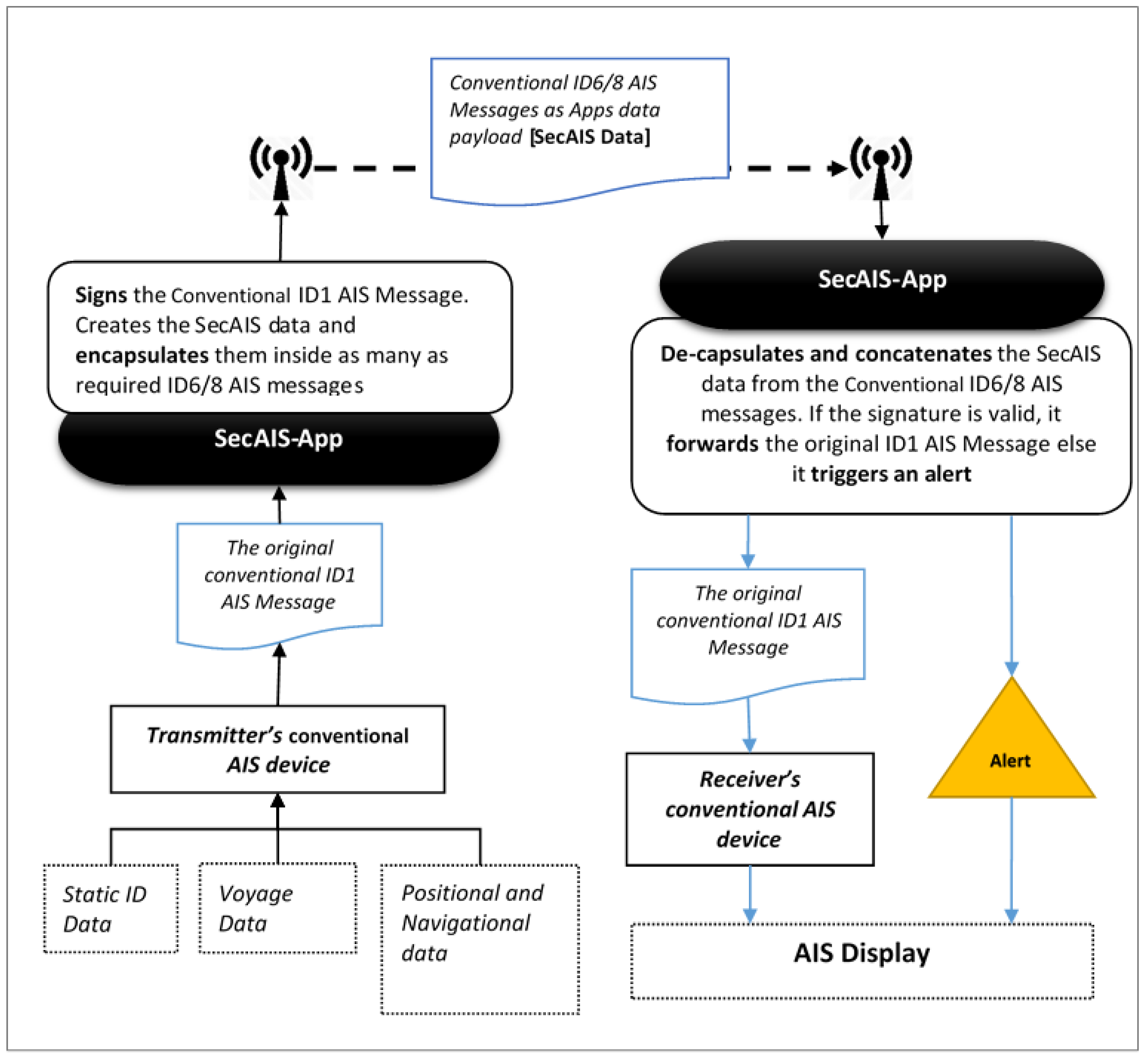

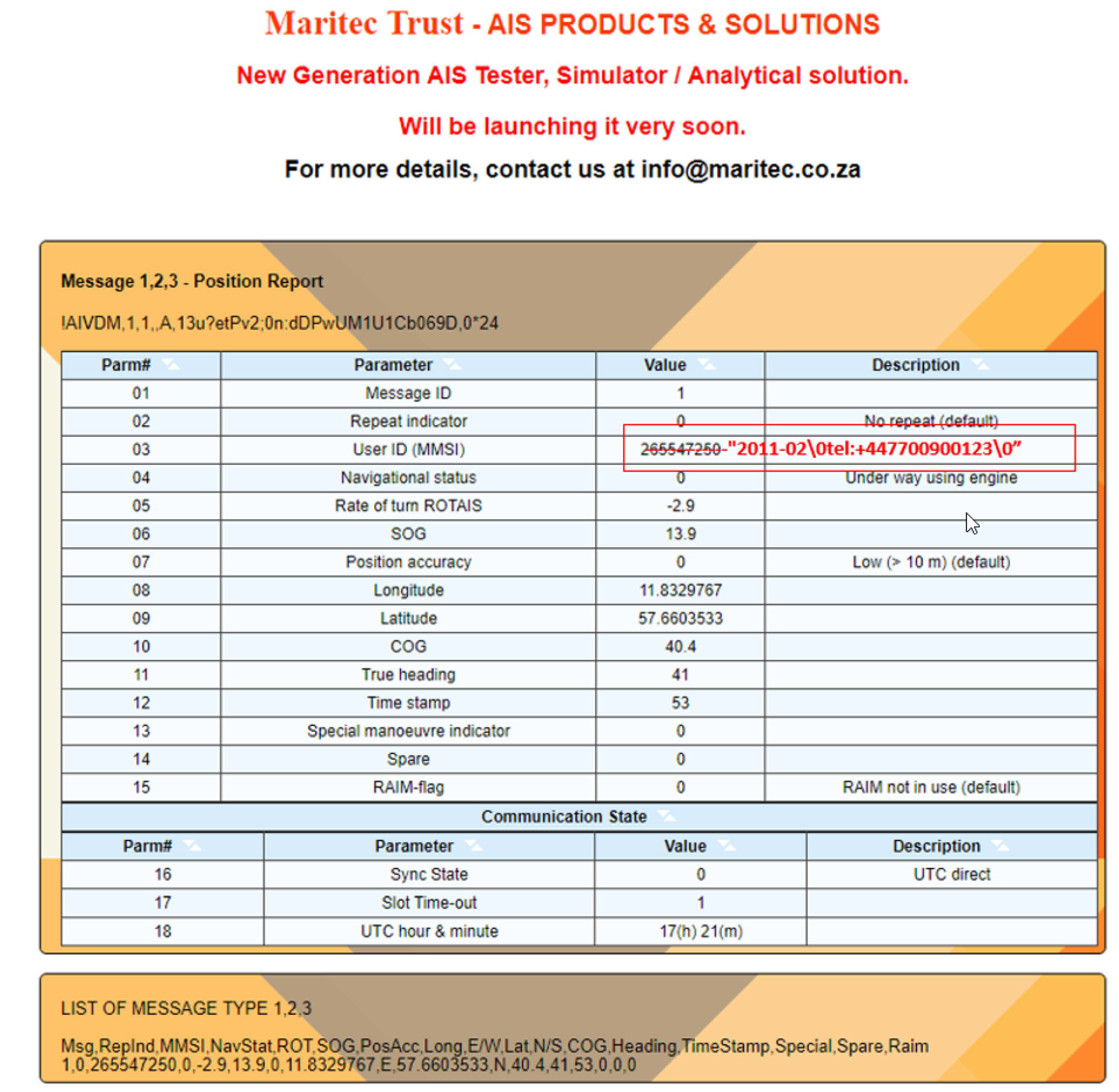
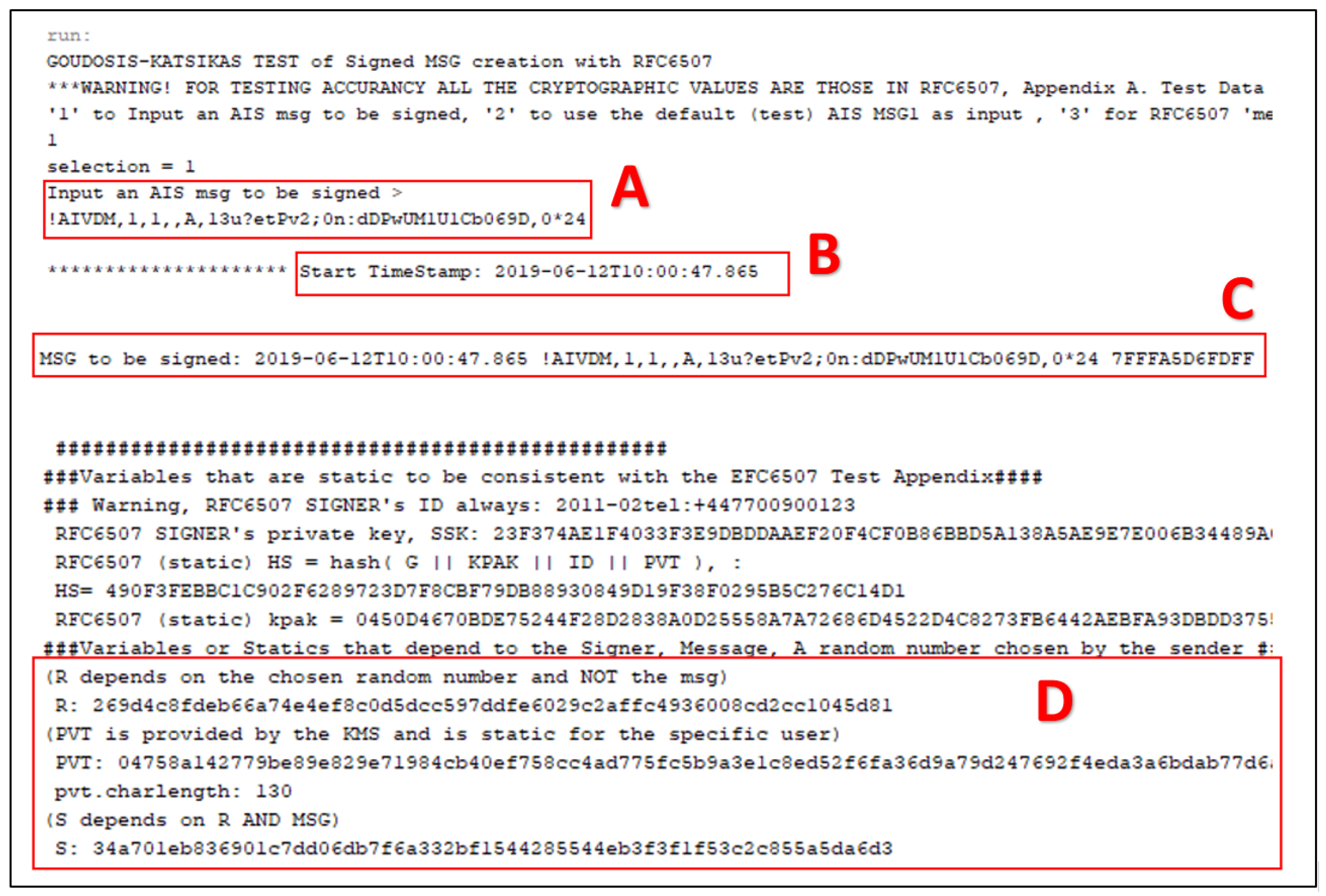
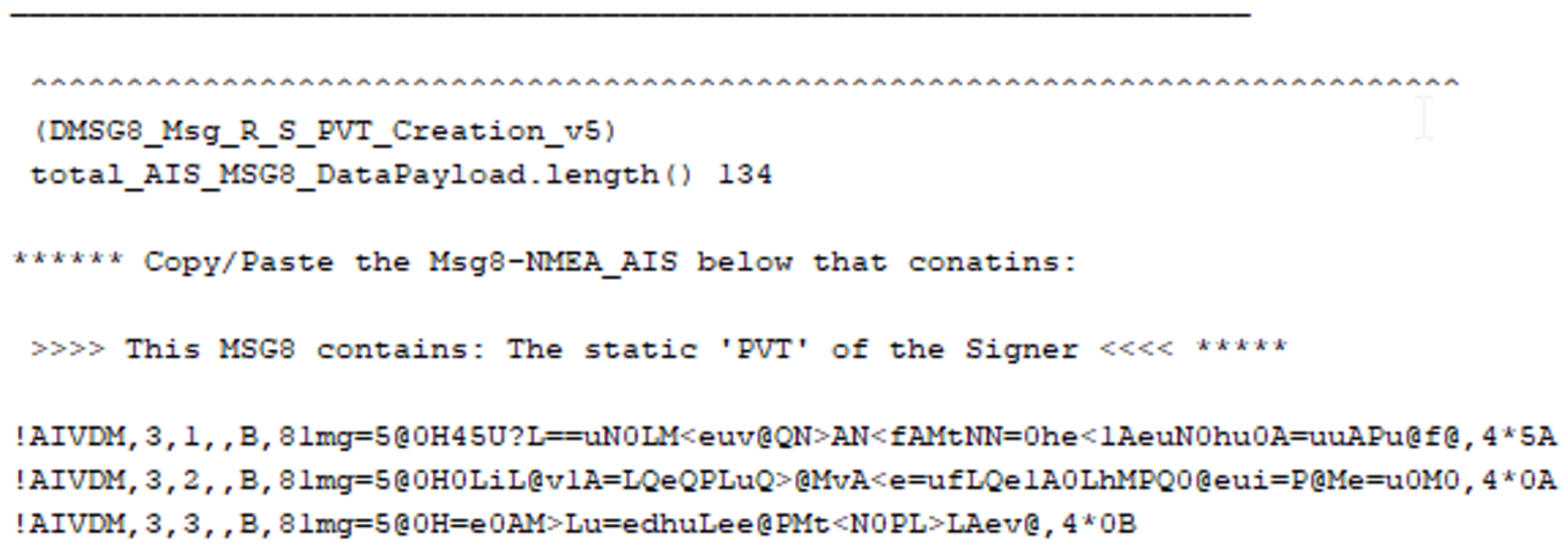


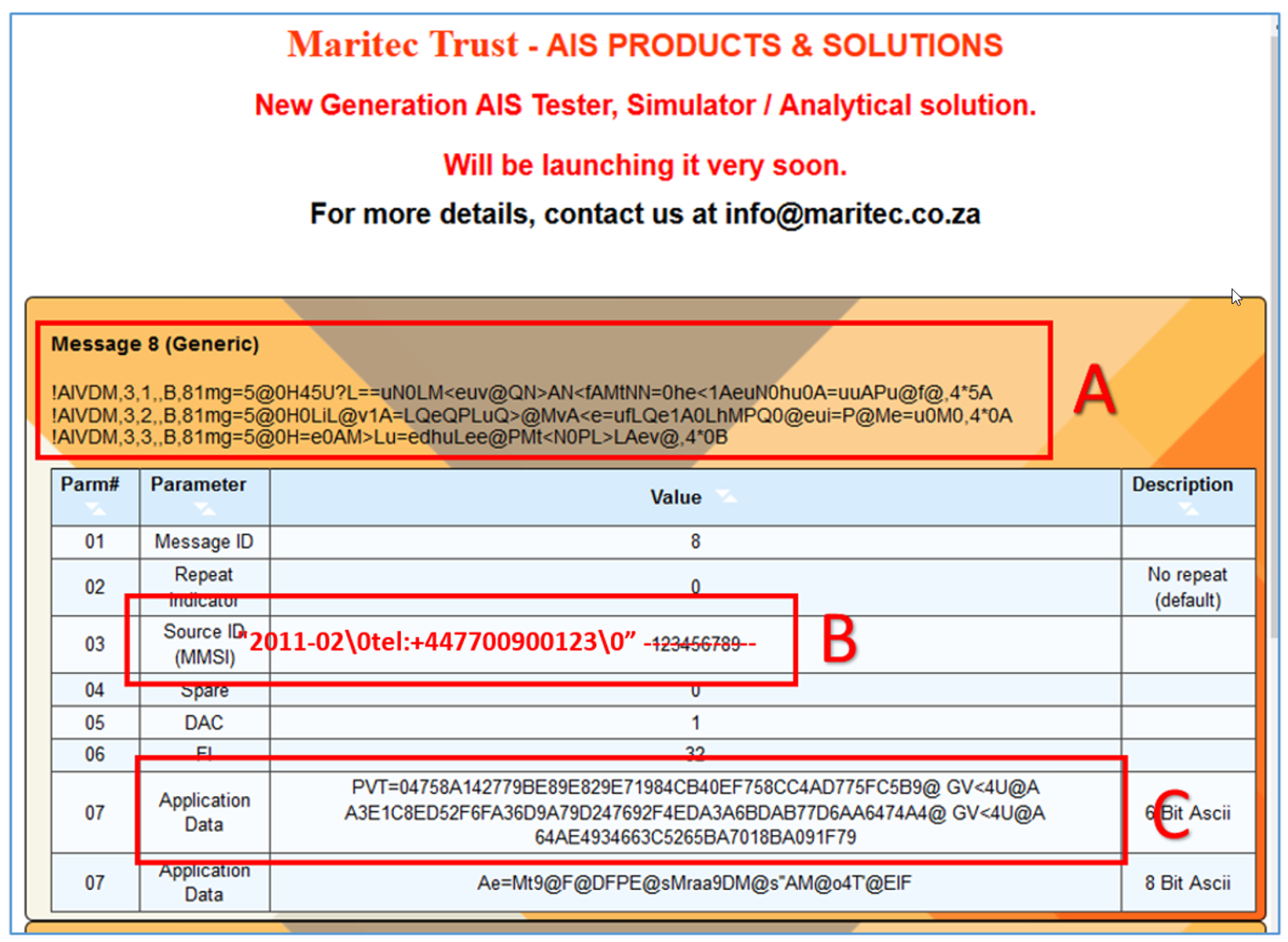
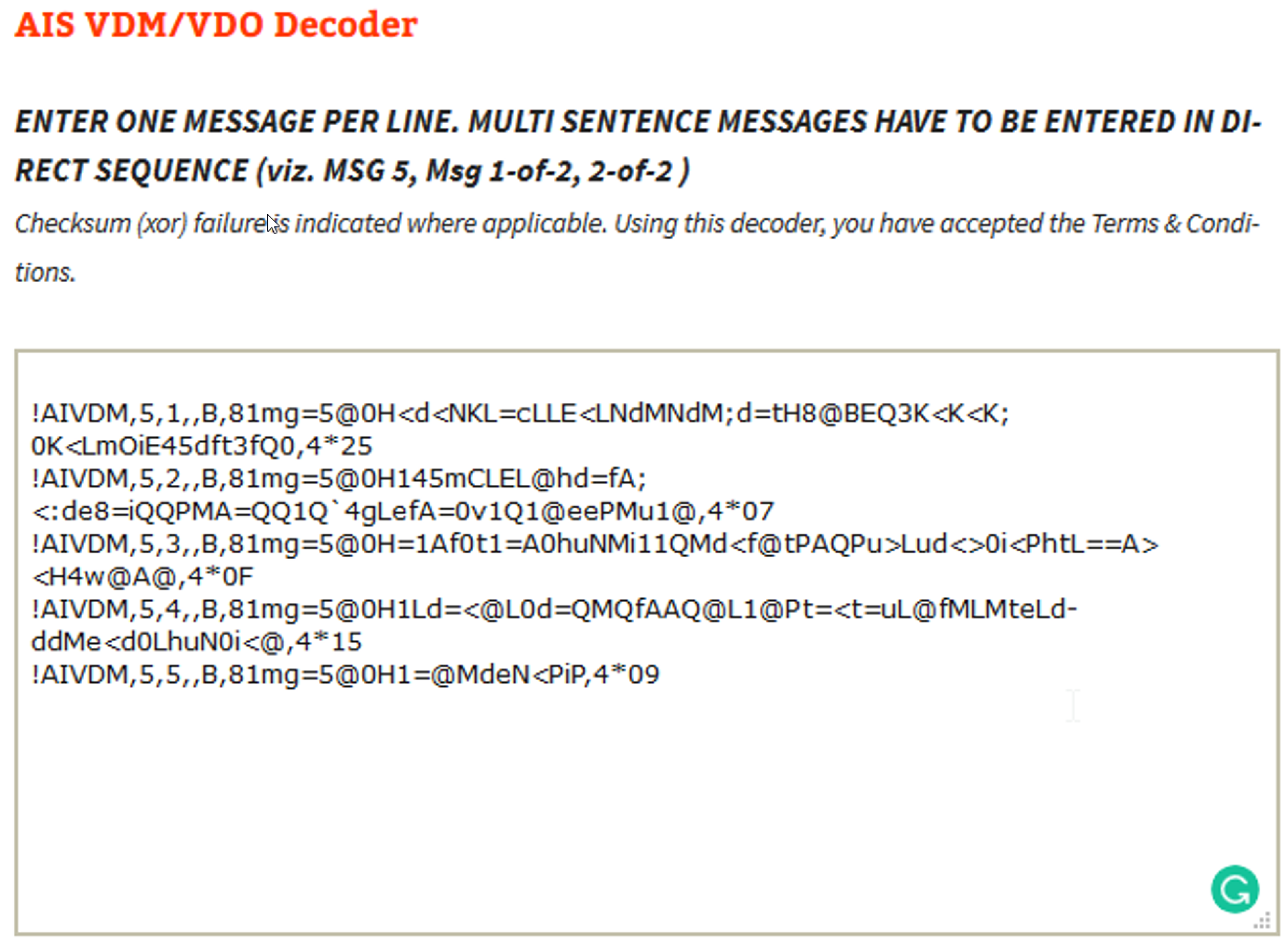
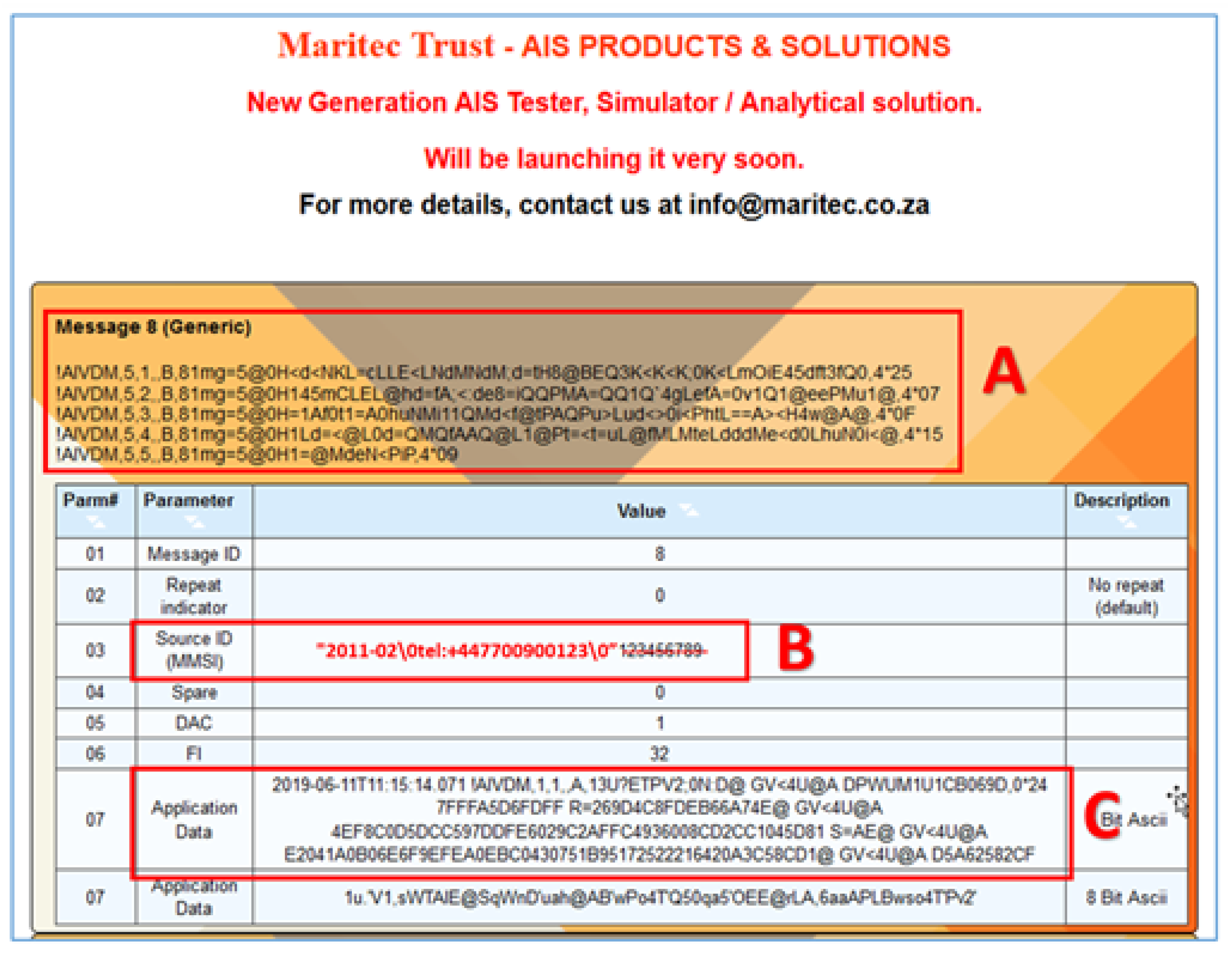

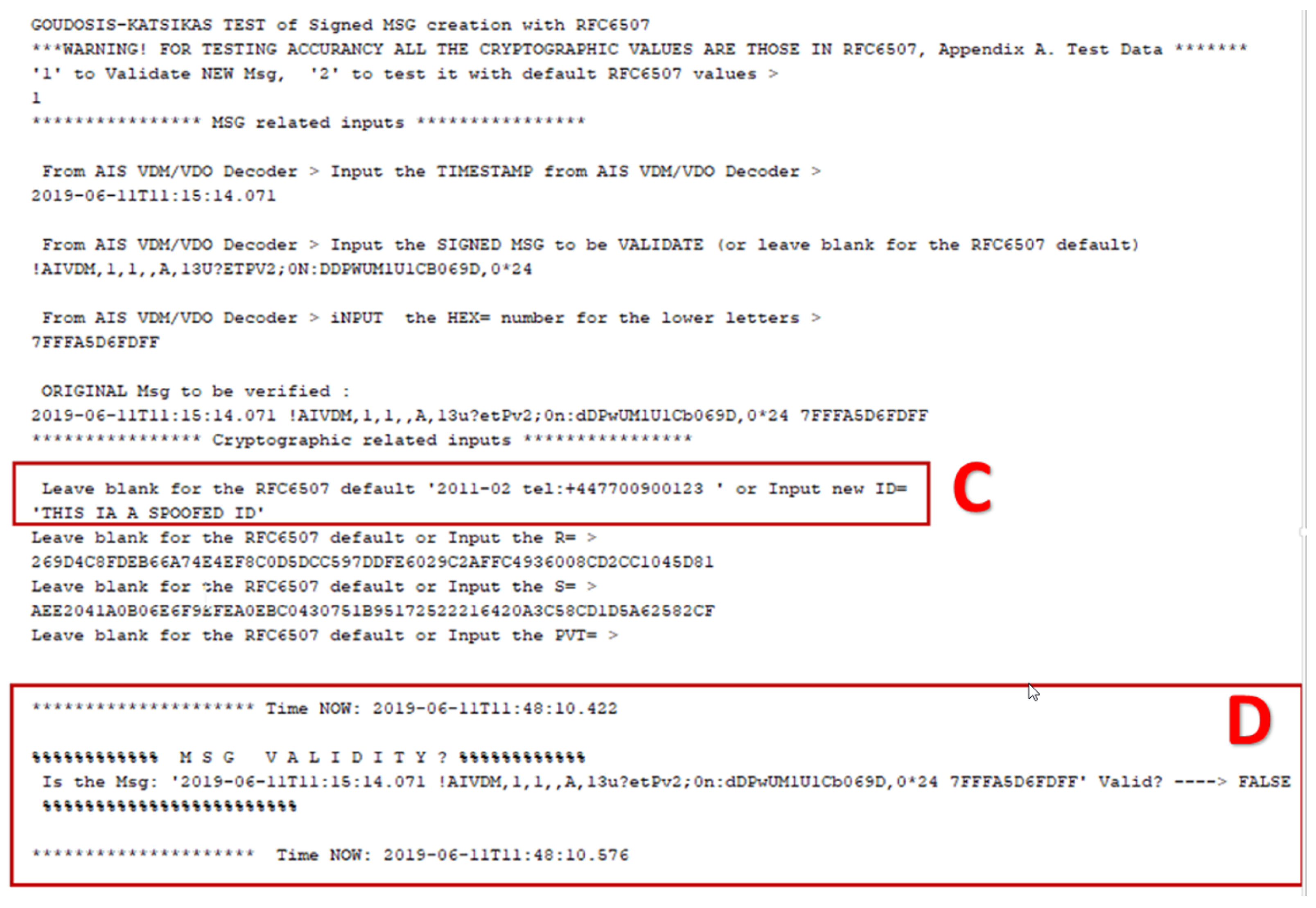
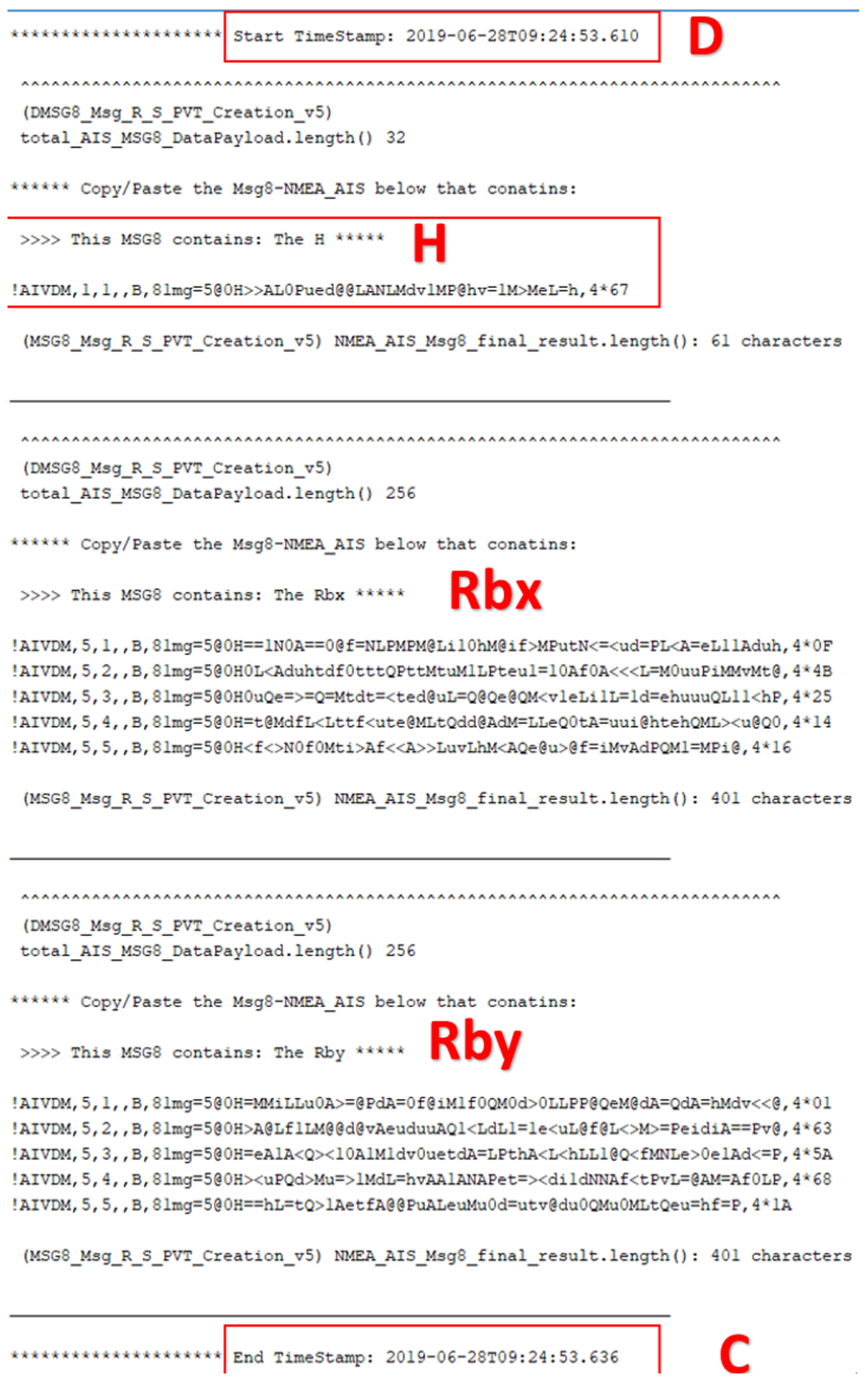
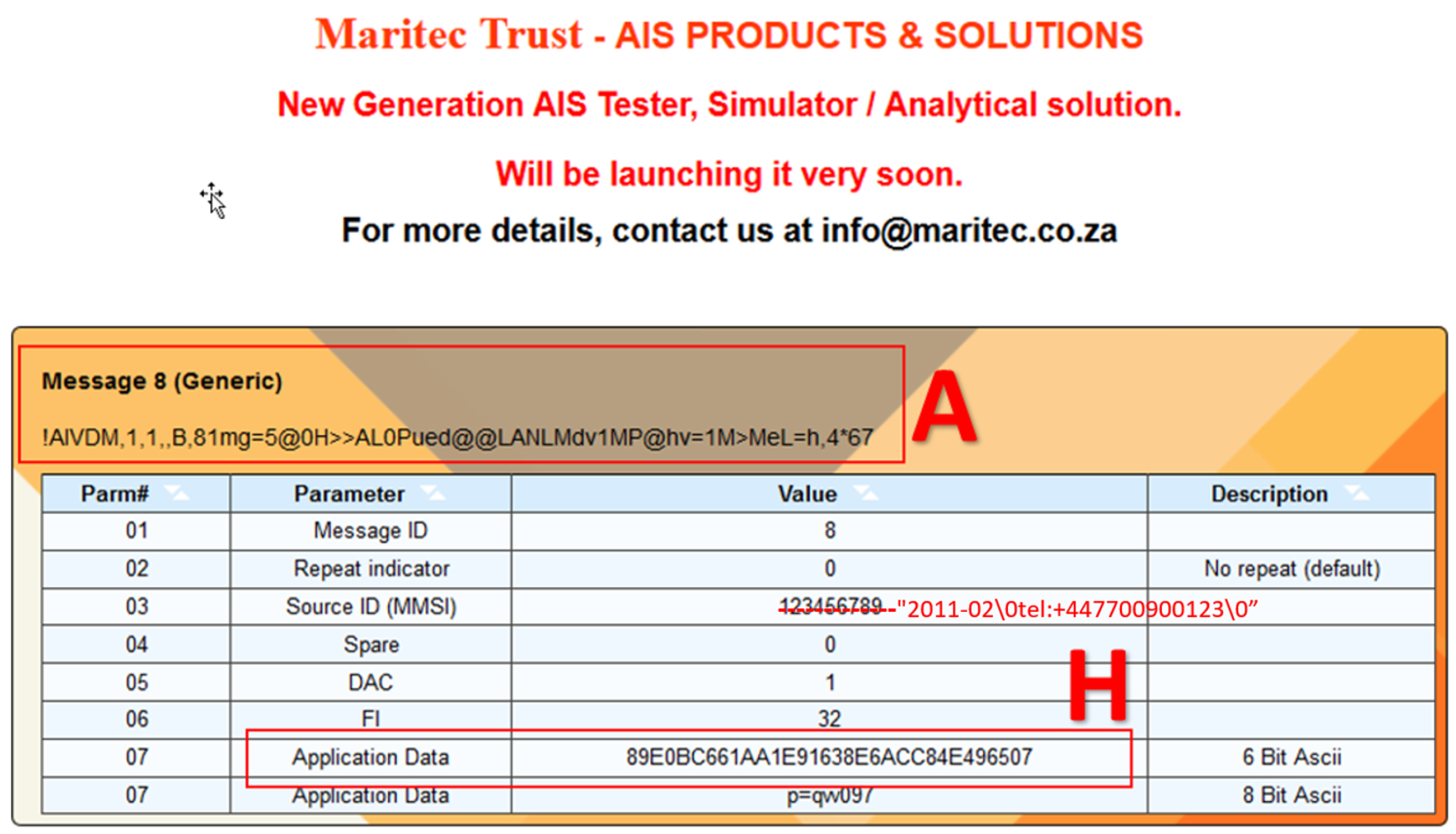
| Parameter | mIBC | PoC Implementation |
|---|---|---|
| Private Key Generator | IMO-mIBC-PKG | PKG |
| mIBC Public Parameters | IMO-mIBC-PKG-PP | Public Parameters of the RFCs |
| Public key | MMSI | ID = “2011-02\0tel: +447700900123\0” |
| Private key | IMO-mIBC-PKG-SKMMSI | Secret-key (SSK) |
Publisher’s Note: MDPI stays neutral with regard to jurisdictional claims in published maps and institutional affiliations. |
© 2022 by the authors. Licensee MDPI, Basel, Switzerland. This article is an open access article distributed under the terms and conditions of the Creative Commons Attribution (CC BY) license (https://creativecommons.org/licenses/by/4.0/).
Share and Cite
Goudosis, A.; Katsikas, S. Secure Automatic Identification System (SecAIS): Proof-of-Concept Implementation. J. Mar. Sci. Eng. 2022, 10, 805. https://doi.org/10.3390/jmse10060805
Goudosis A, Katsikas S. Secure Automatic Identification System (SecAIS): Proof-of-Concept Implementation. Journal of Marine Science and Engineering. 2022; 10(6):805. https://doi.org/10.3390/jmse10060805
Chicago/Turabian StyleGoudosis, Athanasios, and Sokratis Katsikas. 2022. "Secure Automatic Identification System (SecAIS): Proof-of-Concept Implementation" Journal of Marine Science and Engineering 10, no. 6: 805. https://doi.org/10.3390/jmse10060805
APA StyleGoudosis, A., & Katsikas, S. (2022). Secure Automatic Identification System (SecAIS): Proof-of-Concept Implementation. Journal of Marine Science and Engineering, 10(6), 805. https://doi.org/10.3390/jmse10060805







